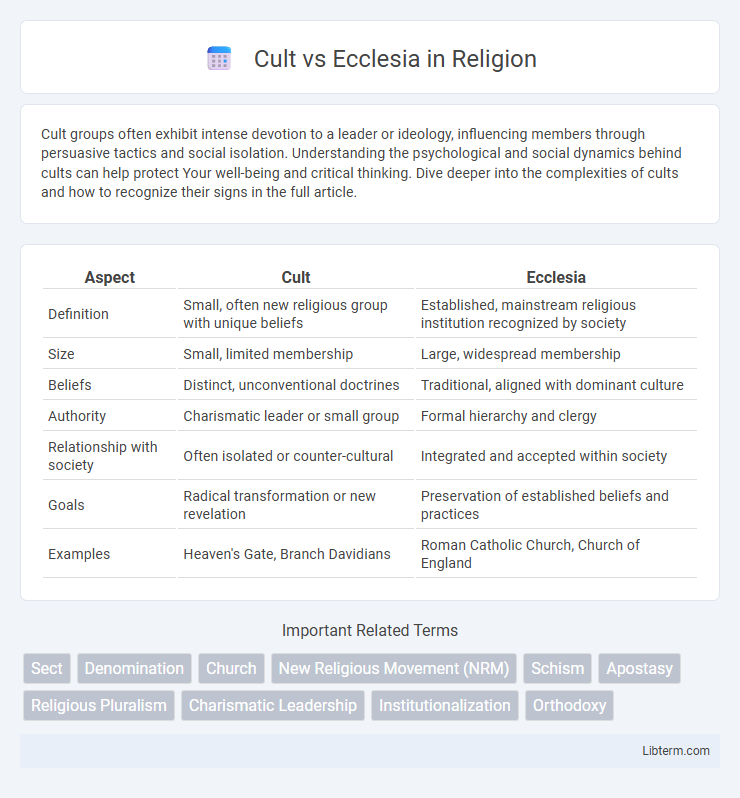Cult groups often exhibit intense devotion to a leader or ideology, influencing members through persuasive tactics and social isolation. Understanding the psychological and social dynamics behind cults can help protect Your well-being and critical thinking. Dive deeper into the complexities of cults and how to recognize their signs in the full article.
Table of Comparison
| Aspect | Cult | Ecclesia |
|---|---|---|
| Definition | Small, often new religious group with unique beliefs | Established, mainstream religious institution recognized by society |
| Size | Small, limited membership | Large, widespread membership |
| Beliefs | Distinct, unconventional doctrines | Traditional, aligned with dominant culture |
| Authority | Charismatic leader or small group | Formal hierarchy and clergy |
| Relationship with society | Often isolated or counter-cultural | Integrated and accepted within society |
| Goals | Radical transformation or new revelation | Preservation of established beliefs and practices |
| Examples | Heaven's Gate, Branch Davidians | Roman Catholic Church, Church of England |
Defining Cults: Key Characteristics
Cults are defined by their intense devotion to a charismatic leader, exclusivity, and often secretive or unconventional beliefs that diverge significantly from mainstream religious practices. They exhibit high levels of control over members' behavior, including isolation from outsiders and strict adherence to group norms, which contrasts with the more inclusive and socially integrated nature of ecclesia. Key characteristics such as authoritarian leadership, manipulation, and a strong us-versus-them mentality distinguish cults from established religious institutions.
Understanding Ecclesia: Features and Functions
Ecclesia represents a large, established religious body integrated into society with formal structures and recognized authority. It functions to unify adherents through common rituals, moral codes, and social norms, often supported by the state or governing institutions. Key features include institutionalized worship, defined leadership hierarchy, and a comprehensive ethical system guiding members' behavior.
Historical Development of Cults and Ecclesia
The historical development of cults and ecclesia reveals distinct evolutionary paths within religious systems, where cults often emerged as smaller, deviant groups with unique rituals diverging from mainstream traditions, while ecclesia grew as dominant institutionalized religions closely tied to the state and social order. In ancient civilizations like Greece and Rome, cults functioned as specialized worship practices dedicated to specific deities, contrasting with ecclesia that embodied the official religion endorsed by political authorities. Over time, ecclesia expanded through centralized doctrines and formal clergy, consolidating religious and political power, whereas cults maintained fluidity and localized influence, often paving the way for new religious movements.
Organizational Structure: Cult vs. Ecclesia
Cults typically exhibit a centralized and authoritarian organizational structure, often revolving around a charismatic leader who holds absolute control over members and doctrines. In contrast, ecclesia possess a more formalized and institutionalized hierarchy with established clergy and standardized rituals that integrate seamlessly with societal norms. This structural distinction influences member engagement, with cults fostering intense personal loyalty and ecclesia promoting broader community participation within recognized religious frameworks.
Membership Patterns and Social Integration
Cult membership often involves voluntary, exclusive commitment with high levels of emotional intensity and personalized belief systems, leading to tight-knit, insular social integration. Ecclesia membership tends to be more inclusive and often ascribed by birth or societal norms, promoting broader social cohesion through shared traditions and institutionalized practices. The divergent social integration patterns reflect cults' emphasis on distinct identity formation versus ecclesiae's role in societal unity and continuity.
Authority and Leadership Comparison
Cult leadership typically centralizes authority in a single charismatic figure, often possessing absolute control over members and doctrines. Ecclesia features a more structured and institutionalized leadership hierarchy, distributing authority among clergy and governing bodies to maintain doctrinal consistency and social stability. This distinction influences organizational dynamics, member autonomy, and the longevity of each religious group.
Rituals and Worship Practices
Cult rituals often involve secretive, highly symbolic ceremonies performed by a select group of initiates, emphasizing intense emotional experiences and direct contact with the divine. Ecclesia worship practices are characterized by formalized, communal rituals such as liturgy, sacraments, and public prayers that reinforce social cohesion and doctrinal consistency. The structured nature of ecclesiastical worship contrasts with the flexible, sometimes ecstatic rites of cults, highlighting differences in authority, membership, and religious expression.
Societal Perception and Legitimacy
Cult groups often face societal suspicion and stigma due to their deviant beliefs and secretive practices, leading to social marginalization and legal scrutiny. Ecclesia, representing established religious institutions integrated into society, enjoys widespread legitimacy granted by historical traditions and state endorsement. Public perception heavily favors ecclesiastical organizations because they align with dominant cultural values and contribute to social cohesion and governance.
Influence on Individual and Community Behavior
Cults exert strong influence on individual behavior through intense loyalty, conformity, and often isolation from mainstream society, promoting a distinct identity that prioritizes group norms over personal autonomy. Ecclesia, as established religious institutions, shape community behavior by integrating spiritual practices within societal structures, encouraging collective rituals and social cohesion aligned with broader cultural values. While cults may foster exclusivity and radical change in smaller groups, ecclesias typically promote widespread social stability and continuity through institutionalized belief systems.
Cults and Ecclesias: Implications for Modern Society
Cults often operate with intense devotion to a charismatic leader and challenge social norms, leading to isolation from mainstream society, while ecclesias represent established religious institutions integrated within the cultural framework. The impact of cults in modern society includes potential psychological manipulation and social fragmentation, whereas ecclesias contribute to community cohesion and moral guidance. Understanding the dynamics between cults and ecclesias is crucial for addressing social stability and ensuring religious freedom within contemporary multicultural environments.
Cult Infographic

 libterm.com
libterm.com